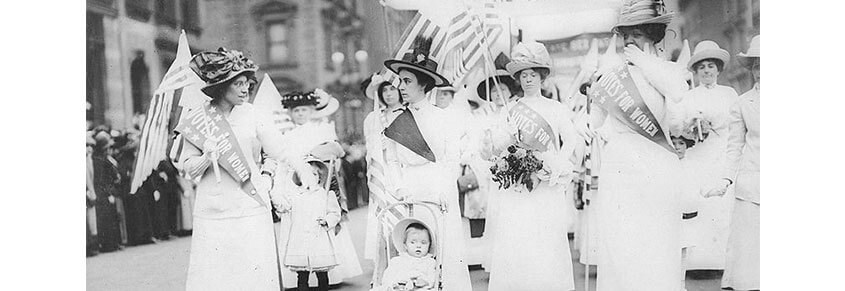As we celebrate the ratification of the bill allowing women to vote, a look back at the complexities and lesser-known stories around the suffragette movement.
This article was made possible because of the generous support of DAME members. We urgently need your help to keep publishing. Will you contribute just $5 a month to support our journalism?
Exactly 97 years ago today on August 18, 1920, the 19th Amendment was ratified, giving U.S. women the constitutional right to vote. As we look back on this historic moment, here are some things you may not know about the fight for women’s suffrage.
Wyoming Was the First Territory to Grant Women the Vote
On December 10, 1869, Governor John A. Campbell made it law for women to have the right to vote. In 1890, Wyoming became the 44th state in the Union, and thus the first state to have women voters. The “Equality State” was also the first in America to elect a woman governor: Nellie Tayloe Ross in 1925.
19 States & Territories Passed Women’s Suffrage Laws Before the 19th Amendment
Along with Wyoming (1869), Utah (1896), Colorado (1893), Idaho (1896), Washington (1910), California (1911), Oregon (1912), Arizona (1912), Kansas (1912), Alaska (1913), Illinois (1913), North Dakota (1917), Indiana (1919), Nebraska (1917), Michigan (1918), Arkansas (1917), New York (1917), South Dakota (1918), and Oklahoma (1918) all passed legislation ahead of 1920 that made it possible for women in those territories and states to participate in elections.
Ratification Came Down to One Tennessee Representative & His Mother
The Tennessee’s state legislature’s decision to ratify the 19th Amendment fell to one man: Representative Harry T. Burn. He was Republican and personally inclined to vote no, but his mother reportedly sent him a letter that said, “Don’t forget to be a good boy and help Mrs. Catt put the ‘rat’ in ratification.” Burn took his mom’s advice, and Tennessee became the decisive 36th state to ratify the 19th Amendment, thus allowing it to become the law of the land.
Propaganda Against Women’s Suffrage Was Full of Shit
Okay, you probably already knew that. But can we talk about some of the ridiculous reasons given against women voting?
1) “Because it means competition of women with men instead of co-operation.”
2) “Because in some States more voting women than voting men will place the Government under petticoat rule.”
3) Because “there is…no method known by which mud-stained reputation may be cleaned after bitter political campaigns.”
And that’s just the tip of the iceberg. SO MUCH PATRIARCHAL FRAGILITY.
The 19th Amendment Did Not Effectively Bring Universal Women’s Suffrage
In theory, the 19th Amendment was supposed to guarantee women the right to vote. In practice, several states still employed voter suppression tactics that targeted people of color. And with the Supreme Court gutting the Voting Rights Act in 2013, there’s even more work to be done to ensure that every American has equal access to the ballot.
Suffragettes Were Pretty Fucking Racist
Something that doesn’t get discussed nearly enough: Leaders of the women’s suffrage movement weren’t exactly intersectional feminists. Black women weren’t always allowed to join women’s rights’ organizations, and there were no Black women at the famous Seneca Falls Convention in 1848. And when the 15th Amendment was proposed in 1869, Susan B. Anthony said, “I will cut off this right arm of mine before I will ever work or demand the ballot for the Negro and not the woman.”
They Also Weren’t Pro-Choice
While reproductive justice has become a cornerstone issue for modern-day feminists, suffragettes were decidedly anti-choice. Elizabeth Cady Stanton called the medical procedure “infanticide”, and Alice Paul asserted that it was “the ultimate exploitation of women.”
A Woman Ran for President Before Women Could Vote Nationwide
Allow me to introduce you to a woman named Victoria Woodhull. Forty-eight years before the 19th Amendment was ratified in 1920, Woodhull ran for the highest office in the land. In May 1872, the Equal Rights Party nominated her as their candidate. It is unknown how many raw votes she received, but suffice it to say, she did not become Commander-in-Chief. Alas, the effort for a woman to break the highest and hardest glass ceiling continues.
The 19th Amendment Paved a Path for the Equal Rights Amendment
In 1923, just three years following 19th Amendment ratification, the Equal Rights Amendment (ERA) was introduced in Congress for the first time. However, it wasn’t until March 22, 1972 that the ERA passed in both chambers of the federal government. Thirty-eight states needed to ratify the ERA, but only 35 had done so by the self-imposed June 30, 1982 deadline. A number of states subsequently passed ratification in one legislative body, and on March 20, 2017, Nevada became the 36th state to ratify the ERA.
